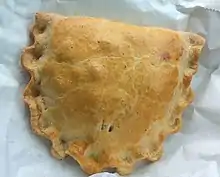 A bridie | |
| Alternative names | Forfar bridie |
|---|---|
| Type | Savoury pasty |
| Place of origin | Scotland |
| Main ingredients | Pie crust, minced steak, butter, beef suet |
A bridie or Forfar bridie is a Scottish meat pasty that originates from Forfar, Scotland.
History and preparation
Bridies are said "to have been 'invented' by a Forfar baker in the 1850s".[1] The name may refer to the pie's frequent presence on wedding menus, or to Margaret Bridie of Glamis, "who sold them at the Buttermarket in Forfar".[2] Bakers in Forfar traditionally use shortcrust pastry for their bridies, but in other parts of Scotland, flaky pastry is sometimes substituted. The filling of a bridie consists of minced steak, butter, and beef suet seasoned with salt and pepper. It is sometimes made with minced onions. Before being baked, the bridie's filling is placed on pastry dough, which is then folded into a semi-circular shape; finally, the edges are crimped. If the baker pokes one hole in the top of a bridie, this indicates that it is plain, or without onions; two holes means that it does contain onions, a convention which is applied also to a Scotch pie.[1]
Cultural references
The bridie is the subject of the Dundee Scots shibboleth Twa bridies, a plen ane an an ingin ane an a (Two bridies, a plain one and an onion one as well).[3]
Forfar Athletic Football Club, who play in the Scottish Professional Football League, have a bridie as their mascot.[4]
See also
- Scotch pie - the most common pastry snack in Scotland
- Pasty - Cornish equivalent
- Turnover (food) - a sweet or savory filled pastry
References
- 1 2 Gow, Rosalie. Modern Ways with Traditional Scottish Recipes. Pelican Publishing, 1981. p. 30. ISBN 0-88289-304-1.
- ↑ "The Forfar Bridie". Jas McLaren & Son. Archived from the original on 24 May 2022. Retrieved 17 September 2014.
- ↑ Hello (29 July 2007). "Jute, jam and student gibberish - The Scotsman". Scotlandonsunday.scotsman.com. Archived from the original on 6 August 2011. Retrieved 13 October 2016.
- ↑ "Loons to launch Bridie the Mascot - The Courier". Archived from the original on 9 August 2020. Retrieved 13 October 2016.